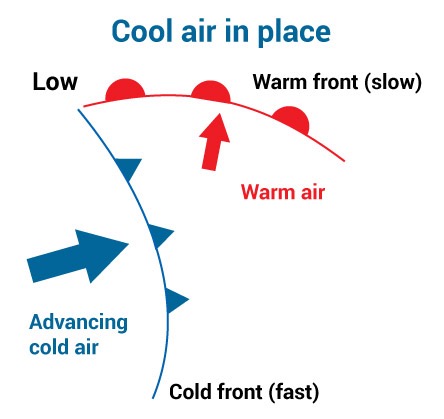What is a Warm Front?
A warm front is a boundary of air that brings warmer temperatures and a change in wind direction and air pressure. Clouds and precipitation develop ahead of a warm front, while clear skies and warmer temperatures can be felt after the warm front moves through. Conversely, during a cold front, clouds and precipitation develop along and behind the cold front and bring a sudden drop in temperature and shift in wind direction.


How Does a Warm Front Form?
Warm fronts usually form on the leading edge of a low pressure system, which is generally on the northeastern side, bringing warmer temperatures from the south, northward. On weather maps, they are defined as red half-circles that point in the direction that the front is moving.
When Does Rain Occur in a Warm Front?
Rain occurs on the leading edge of a warm front. Since warm air is less dense than cold air, it gradually advances over the cold air in a process called gradual frontal lifting and allows for precipitation to develop ahead of the frontal boundary.
Can I Measure a Warm Front?
The AcuRite Atlas™ and AcuRite Iris™ wireless weather stations can measure the passage of frontal boundaries right at your home! By observing rapid increases in temperature combined with drastic wind shifts, your home weather station can detect warm fronts! You can also watch for the precipitation that falls ahead of the warm front because monitoring rainfall is important for our home and garden!
Warm vs. Cold Fronts
Cold fronts and warm fronts are both defined by a sudden change in temperature and a drastic change in wind direction. The difference between these two types of fronts is where the precipitation occurs. Precipitation develops ahead of warm fronts, whereas it develops along and behind cold fronts — important to remember when wanting to measure rainfall!






